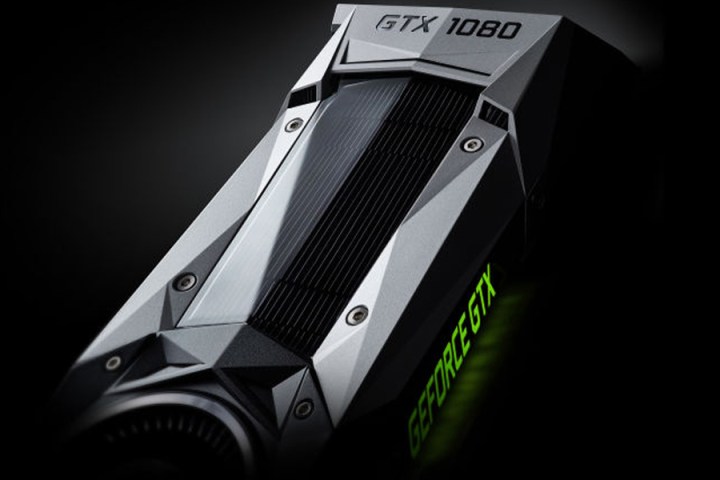
We haven’t been able to spend time with the card yet, but we’ve scoured the web for benchmarks, features, and design impressions so you don’t have to.
What’s old is new again
Like most new GPUs, the first example of the GTX 1080 is the Nvidia produced reference design, or “Founders Edition,” as the company has dubbed it. This time around, the introductory version of the card actually packs some special features, though. For one, the previous heat pipe and blower construction has been improved with the return of the vapor chamber from the original Titan introduction, and the power supply has been upgraded to a five-phase unit.
Its redesigned shroud is also much more exciting and dangerous looking than the previous blower. Whether the jagged edges and tessellated appearance fit in with your build is up to personal taste, but its efficiency can’t be argued with. The reviewers that measured temperatures found the card’s power efficiency and temperatures have both improved a bit over last year, despite the performance increase.
The GTX 1080 boasts improved connectivity too, even if it doesn’t appear to from the outside. The trio of DisplayPorts are now 1.4 instead of 1.2m for up to 8K at 60Hz or 4K at 120Hz, and the HDMI port is now 2.0B, for 4K at 60Hz with High Dynamic Range, a feature the GTX 1080 now supports.
Take a picture
Basically every feature and specification on the GTX 1080 has improved over the GTX 980. There are more stream processors, more CUDA cores, improved memory bandwidth, and a shrunken architecture, but we’ll get to what exactly that means for performance. First, we’ll take a look at a couple of features that reviewers mentioned specifically having tried out.
One of the more important additions, especially considering the high framerates the GTX 1080 achieved, is the new Fast Sync technology. Like a G-Sync for framerates that fly past your monitor’s refresh rate, Fast Sync lets your GPU render frames as fast as it wants, and then the card decides which frames to show. That means dropped frames, but most reviewers pointed out that this feature works quite well for games like Dota 2 or Counter-Strike: Global Offensive where speed is everything, and quality isn’t the goal.
There’s also the new Ansel feature, which allows users to take incredibly detailed in-game screenshots in 2D or 360-degree for VR. It’s a driver utility that has to be enabled by each game’s developer, but doing so in The Witness only required 40 lines of extra code, according to the PCWorld review. The result is a free-floating camera that stitches together up to 3,600 individual, high-resolution shots, with special filters and effects to improve your photography.
Although Nvidia makes no claims about the GTX 1080’s overclocking potential, its unlocked cores and improved tuning are sure to grab gaming enthusiasts’ attention. One of them is GPU Boost 3.0, which allows users to set different overclocking settings depending on the card’s current voltage.
King of the hill
The result of these new features and generational improvements is impressive, but the benchmarks speak for themselves, especially at lower resolutions. We could share 1080p results, but with even mid-range components backing it up, expect the GTX 1080 to stay well above 60 frames per second in basically any modern game.
As the resolution rises, so does the GTX 1080’s lead over comparable cards. With the exception of SLI or CrossFire setups, and DirectX 12 games where AMD currently has an advantage, the GTX 1080 doesn’t lose a benchmark to a single GPU setup in any of the reviews we checked. In a fifteen game average, the GTX 1080 ties or beats two GTX 980s in SLI, trouncing every other card in the competition, according to PCGamer’s review. That kind of overwhelming, unambiguous victory is a rarity in the PC gaming market.
Overall, the GTX 1080 is tough to compare to the GTX 980 because it’s so much faster – about a 70 percent jump, according to Anandtech. Instead, it’s a more direct comparison to the 980 Ti, at least in terms of price. Even then, the GTX 1080 is over 30 percent faster than the 980 Ti, and it carries a slightly higher margin of victory over AMD’s Fury X.
Conclusion
At the end of the day, the new GTX 1080 is a vast improvement over last year’s cards, and even beats out two GTX 980s in SLI on a good day. It also quickly claimed the title of fastest single graphics card setup for consumers in the gaming space, at a price that comes in well below cards like the Titan X that it beats.
Reference cards haven’t always been gamers’ first choice, and this one carries a larger premium than ever. It’s more likely than ever that PC builders will chase down a overclocked version of their favorite third-party cooler if they want to upgrade to the 1080, and save some cash in the process.
We’ll wait until we have the GTX 1080 in hand to settle on a formal score or recommendation, but it’s clear the newest generation of Nvidia cards are geared up for a successful summer, especially once the non-reference designs roll out.



